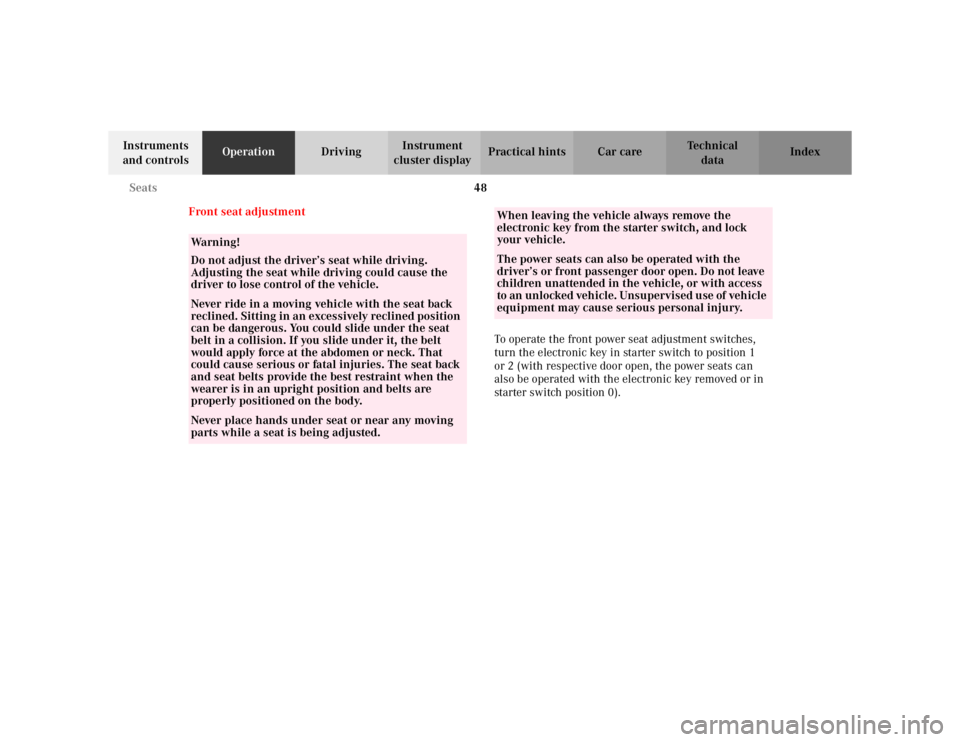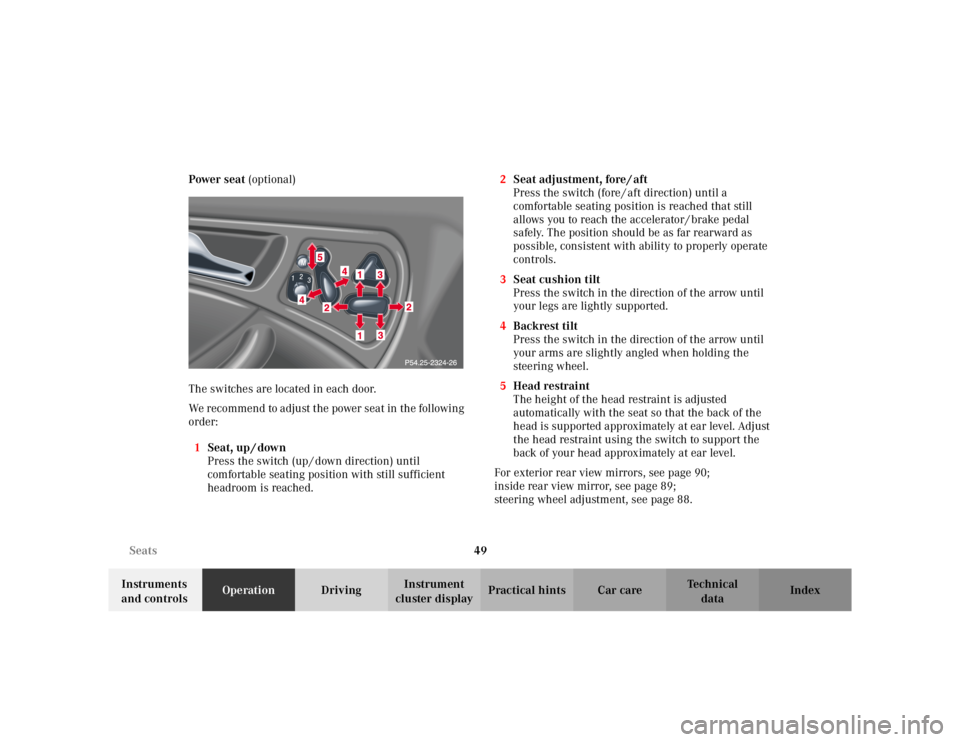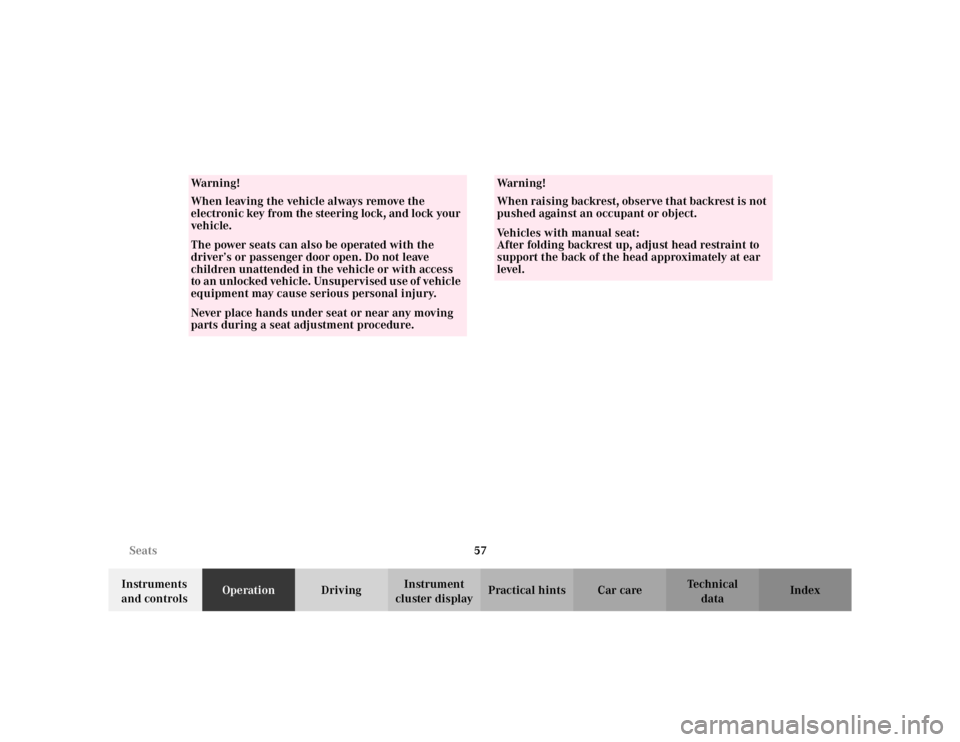MERCEDES-BENZ C CLASS COUPE 2002 Workshop Manual
Manufacturer: MERCEDES-BENZ, Model Year: 2002, Model line: C CLASS COUPE, Model: MERCEDES-BENZ C CLASS COUPE 2002Pages: 399, PDF Size: 16.59 MB
Page 51 of 399

48
Seats
Te ch n i c a l
data
Instruments
and controls Operation
DrivingInstrument
cluster display Practical hints Car care Index
Front seat adjustment
To operate the front power seat adjustment switches,
turn the electronic key in starter switch to position 1
or 2 (with respective door open, the power seats can
also be operated with the electronic key removed or in
starter switch position 0).
Wa r n i n g !
Do not adjust the driver’s seat while driving.
Adjusting the seat while driving could cause the
driver to lose control of the vehicle.Never ride in a moving vehicle with the seat back
reclined. Sitting in an excessively reclined position
can be dangerous. You could slide under the seat
belt in a collision. If you slide under it, the belt
would apply force at the abdomen or neck. That
could cause serious or fatal injuries. The seat back
and seat belts provide the best restraint when the
wearer is in an upright position and belts are
properly positioned on the body.Never place hands under seat or near any moving
parts while a seat is being adjusted.
When leaving the vehicle always remove the
electronic key from the starter switch, and lock
your vehicle. The power seats can also be operated with the
driver’s or front passenger door open. Do not leave
children unattended in the vehicle, or with access
to an unlocked vehicle. Unsupervised use of vehicle
equipment may cause serious personal injury.
Page 52 of 399

49
Seats
Te ch n i c a l
data
Instruments
and controls Operation
DrivingInstrument
cluster display Practical hints Car care Index
Power seat
(optional)
The switches are located in each door.
We recommend to adjust the power seat in the following
order: 1 Seat, up / down
Press the switch (up / down direction) until
comfortable seating position with still sufficient
headroom is reached. 2
Seat adjustment, fore / aft
Press the switch (fore / aft direction) until a
comfortable seating position is reached that still
allows you to reach the accelerator / brake pedal
safely. The position should be as far rearward as
possible, consistent with ability to properly operate
controls.
3 Seat cushion tilt
Press the switch in the direction of the arrow until
your legs are lightly supported.
4 Backrest tilt
Press the switch in the direction of the arrow until
your arms are slightly angled when holding the
steering wheel.
5 Head restraint
The height of the head restraint is adjusted
automatically with the seat so that the back of the
head is supported approximately at ear level. Adjust
the head restraint using the switch to support the
back of your head approximately at ear level.
For exterior rear view mirrors, see page 90;
inside rear view mirror, see page 89;
steering wheel adjustment, see page 88.
Page 53 of 399

50
Seats
Te ch n i c a l
data
Instruments
and controls Operation
DrivingInstrument
cluster display Practical hints Car care Index
Adjust the head restraint angle by hand. Push or pull
the head restraint in direction of arrow. Storing seat positions:
(only vehicles with memory function)
The steering wheel and exterior rear view mirror
position are stored together with the seat position.
See page 93 for notes on the memory function. For
recalling a stored seat / head restraint / steering wheel /
and exterior rear view mirror position see page 94.
Page 54 of 399

51
Seats
Te ch n i c a l
data
Instruments
and controls Operation
DrivingInstrument
cluster display Practical hints Car care Index
Manual seat
(standard) We recommend to adjust the seat in the following order:
1Fore/aft adjustment
Lift handle (1), slide seat to desired position and
allow handle to reengage. Check for proper
engagement before driving.
2 Seat cushion tilt
Turn handwheel (2) forward or backward.
3 Seat height adjustment
Pull handle (3) up to raise seat cushion.
Push handle (3) down to lower seat cushion.
4 Backrest tilt
Turn handwheel (4) forward or backwards until
your arms are slightly angled when holding the
steering wheel.
Page 55 of 399

52
Seats
Te ch n i c a l
data
Instruments
and controls Operation
DrivingInstrument
cluster display Practical hints Car care Index
5 Head restraint height
Raising:
Pull up on head restraint.
Lowering:
Push button (5) and push down on head restraint.
Adjust head restraint to support the back of the head
approximately at ear level. The head restraint
inclination can also be adjusted manually. Head restraint inclination
Push or pull the head restraint in direction of arrow.
Page 56 of 399

53
Seats
Te ch n i c a l
data
Instruments
and controls Operation
DrivingInstrument
cluster display Practical hints Car care Index
Important!
Prior to operating the vehicle, the driver should adjust
the seat height for proper vision as well as fore/aft
placement and backrest angle to insure adequate
control, reach, operation, and comfort. The head
restraint should also be adjusted for proper height. See
also airbag section on page 72 for proper seat
positioning.
In addition, also adjust the steering wheel to ensure
adequate control, reach, operation, and comfort.
Both the inside and outside rear view mirrors should be
adjusted for adequate rearward vision.
Fasten seat belts. Infants and small children should be
seated in a properly secured restraint system that
complies with U.S. Federal Motor Vehicle Safety
Standard 213 and Canadian Motor Vehicle Safety
Standard 213.
All seat, head restraint, steering wheel, and rear view
mirror adjustments as well as fastening of seat belts
should be done before the vehicle is put into motion.
Wa r n i n g !
Children 12 years old and under must never ride in
the front seat, except in a Mercedes-Benz
authorized BabySmart
TM compatible child seat,
which operates with the BabySmart
TM system
installed in the vehicle to deactivate the passenger
side front airbag when it is properly installed.
Otherwise they will be struck by the airbag when it
inflates in a crash. If this happens, serious or fatal
injury can result.
According to accident statistics, children are safer
when properly restrained in the rear seating
positions than in the front seating positions.
Infants and small children must ride in back seats
and be seated in an appropriate infant or child
restraint system, which is properly secured with
the vehicle’s seat belt, fully in accordance with the
child seat manufacturer’s instructions.A child’s risk of serious or fatal injuries is
significantly increased if the child restraints are
not properly secured in the vehicle and the child is
not properly secured in the child restraint.
Page 57 of 399

54
Seats
Te ch n i c a l
data
Instruments
and controls Operation
DrivingInstrument
cluster display Practical hints Car care Index
Removal and installation of front seat head
restraints
Power seat
Caution!
Do not remove head restraints except when mounting
seat covers. Whenever restraints have been removed be
sure to reinstall them before driving. Note:
Tilt the backrest rearward for easier removal and
installation of the head restraints.
To r e m ove :
Press switch (1) upwards and hold until the head
restraint is fully extended. Pull head restraint out.
To i n st a l l :
Press switch (1) upwards and hold for about 5 seconds.
Press the head restraint down until it engages.
Adjust head restraint to the desired position.
Wa r n i n g !
For your protection, drive only with properly
positioned head restraints.Adjust head restraint to support the back of the
head approximately at ear level.Do not drive the vehicle without the seat head
restraints. Head restraints are intended to help
reduce injuries during an accident.
Page 58 of 399

55
Seats
Te ch n i c a l
data
Instruments
and controls Operation
DrivingInstrument
cluster display Practical hints Car care Index
Manual seat
To remove:
Pull head restraint to its highest position. Push
button (1) and pull out head restraint completely.
To install:
Insert head restraint and push it down to the stop. Push
button (1) and adjust head restraint to the desired
position.
Wa r n i n g !
For your protection, drive only with properly
positioned head restraints.Adjust head restraint to support the back of the
head approximately at ear level.Do not drive the vehicle without the seat head
restraints. Head restraints are intended to help
reduce injuries during an accident.
Page 59 of 399

56
Seats
Te ch n i c a l
data
Instruments
and controls Operation
DrivingInstrument
cluster display Practical hints Car care Index
Front seat backrest - locking and unlocking
1 Release lever
Folding forward:
Lift release lever (1) and fold backrest forward, when
necessary, lower head restraint by pushing it.
Note:
Vehicles with power seat:
The seat will automatically slide forward and the head
restraints will move down. Folding back:
Fold backrest back until it locks securely in place.
Adjust head restraint to support the back of the head
approximately at ear level, see page 52.
Note:
Vehicles with power seat:
The seat and head restraint return to their previous
positions.
Page 60 of 399

57
Seats
Te ch n i c a l
data
Instruments
and controls Operation
DrivingInstrument
cluster display Practical hints Car care Index
Wa r n i n g !
When leaving the vehicle always remove the
electronic key from the steering lock, and lock your
vehicle.The power seats can also be operated with the
driver’s or passenger door open. Do not leave
children unattended in the vehicle or with access
to an unlocked vehicle. Unsupervised use of vehicle
equipment may cause serious personal injury.Never place hands under seat or near any moving
parts during a seat adjustment procedure.
Wa r n i n g !
When raising backrest, observe that backrest is not
pushed against an occupant or object.Vehicles with manual seat:
After folding backrest up, adjust head restraint to
support the back of the head approximately at ear
level.